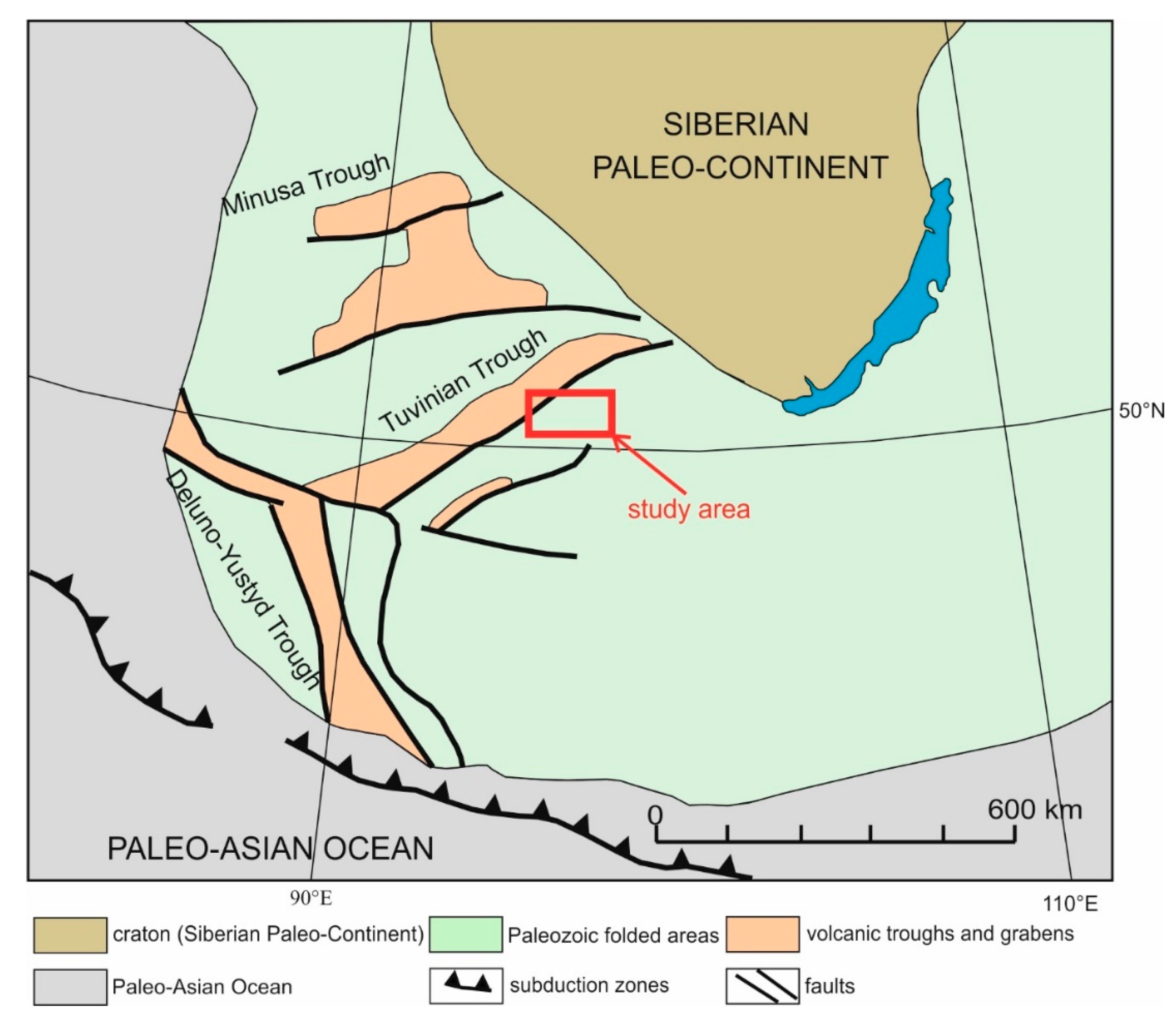Tectonic History of the South Tannuol Fault Zone (Tuva Region of the Northern Central Asian Orogenic Belt, Russia): Constraints from Multi-Method Geochronology
Abstract
1. Introduction
2. Methods
2.1. Zircon U/Pb Dating
2.2. Plagioclase and K-Feldspar 40Ar/39Ar Dating
2.3. Apatite Fission-Track (AFT) Dating
3. Results and Discussion
3.1. Zircon U/Pb Dating
3.2. Plagioclase and K-Feldspar 40Ar/39Ar Dating
3.3. AFT Thermochronometry
4. Conclusions
- Cambrian (~510 Ma) zircon U/Pb ages of felsic volcanic rocks and a single inherited grain in a Permian gabbro demonstrates synchronicity with granitoid magmatism that is widespread in the Altay–Sayan area. This is interpreted as the age of island-arc volcanism within the STFZ basement during the final stage of its formation.
- Ordovician (460–450 Ma) zircon U/Pb ages for rhyodacites were obtained along the STFZ structures for the first time and indicate the presence of locally developed Ordovician volcanism. Ordovician volcanism is contemporaneous with Ordovician granitoid magmatism and marks the subsequent activation episode of the STFZ during the collision events on the southwest Siberian continental margin.
- Early Devonian (~410–400 Ma) and Late Devonian–early Carboniferous (~365 and 340 Ma) activation episodes accompanied by the post-magmatic development of small basic bodies along the STFZ were determined by plagioclase and K-feldspar 40Ar/39Ar dating. These episodes of tectonic activation of the STFZ are probably related to the rifting processes at the backarc region of the active continental margin.
- An Early Permian (~290 Ma) zircon U/Pb gabbro age is atypical for the STFZ and eastern Altay–Sayan region. The geodynamic setting of these gabbroids requires substantial further study but we might assume a connection with the North Asian mantle plume and its interaction with the Northern Asia lithosphere.
- Late Cretaceous (~80 and 75 Ma) and early-middle Paleogene (~60–40 Ma) AFT ages are preserved in the crystalline basement along the STFZ. Thermal history modelling of the AFT data shows a Cretaceous–Eocene (~100–40 Ma) cooling episode. These ages and Cretaceous–Eocene cooling are interpreted as reflecting a period of renewed STFZ reactivation.
- As shown in the thermal history models, the basement along the STFZ experienced temporary thermal stagnation and possibly even re-heating during the Eocene–Miocene (~40–10 Ma). This period of STFZ tectonic quiescence is evidenced by the sedimentary record of the Cenozoic Ubsunur Basin. During this period, a lake occupied the Ubsunur Basin, and its lacustrine sediments show deeper depositional environments from the Eocene to Miocene.
- Finally, the late Neogene (from ~10 Ma onwards), the STFZ experienced renewed reactivation, resulting in the formation of the present-day mountainous topography under changing climate conditions. This reactivation episode, if not enhanced by modeling artefacts, is most likely associated with a far-field effect of the India–Eurasia collision, south of our study area, and the consequential development of the present-day mountainous topography in the area.
Supplementary Materials
Author Contributions
Funding
Acknowledgments
Conflicts of Interest
References
- Babin, G.A.; Shokalsky, S.P. Major geological features of the Altai–Sayan Folded Region (tectonic zoning, stratigraphy, magmatism, geological evolution). Geol. Miner. Resour. Sib. 2017, 6c, 19–37. (In Russian) [Google Scholar]
- Berzin, N.A.; Kungurtsev, L.V. Geodynamic interpretation of Altai–Sayan Geological complexes. Russ. Geol. Geophys. 1996, 37, 56–73. [Google Scholar]
- Gordienko, I.V.; Metelkin, D.V. The evolution of the subduction zone magmatism on the Neoproterozoic and Early Paleozoic active margins of the Paleoasian Ocean. Russ. Geol. Geophys. 2016, 57, 56–73. [Google Scholar] [CrossRef]
- Zonenshain, L.P.; Kuzmin, M.P.; Natapov, L.M. Geology of USSR: A Plate Tectonic Synthesis; Geodynamic Series; American Geophysical Union: Washington, DC, USA, 1990; Volume 21, p. 242. [Google Scholar]
- Vetrov, E.V.; Chernykh, A.I.; Babin, G.A. Early Paleozoic granitoid magmatism in the East Tannu-Ola sector of the Tuvinian magmatic belt: Geodynamic position, age, and metallogeny. Russ. Geol. Geophys. 2019, 60, 492–513. [Google Scholar]
- Rudnev, S.N.; Kovach, V.P.; Ponomarchuk, V.A. Vendian–Early Cambrian island-arc plagiogranitoid magmatism in the Altai–Sayan folded area and in the Lake Zone of western Mongolia (geochronological, geochemical, and isotope data). Russ. Geol. Geophys. 2013, 54, 1272–1287. [Google Scholar] [CrossRef]
- Mongush, A.A.; Lebedev, V.I.; Kovach, V.P.; Sal’nikova, E.B.; Druzhkova, E.K.; Yakovleva, S.Z.; Plotkina, Y.V.; Zagornaya, N.Y.; Travin, A.V.; Serov, P.A. The tectonomagmatic evolution of structure-lithologic complexes in the Tannu–Ola zone, Tuva, in the Late Vendian–Early Cambrian (from geochemical, Nd isotope, and geochronological data). Russ. Geol. Geophys. 2011, 52, 503–516. [Google Scholar] [CrossRef]
- Berzon, E.I.; Petruhina, O.N. Stratigraphic subdivision of the Jurassic System of the Ulughem coal basin (Republic of Tuva). Reg. Geol. Metallog. 2016, 68, 30–41. (In Russian) [Google Scholar]
- Ivantsov, S.V.; Kostesha, O.N.; Krasnolutsky, S.A.; Lyaluk, K.P. New location of the Middle Jurassic vertebrates Novoaltatsky section: A comprehensive study and paleogeographic interpretation. Bull. TSU 2009, 328, 220–225. (In Russian) [Google Scholar]
- Berzon, E.I.; Smokotina, I.V. New data on litho- and biostratigraphy of the Ulug–Khem coalfield (Tuva). Jurassic System in Russia: Issues of Stratigraphy and Paleogeography. In Proceedings of the VI All-Russian Meeting, Makhachkala, Russia, 15–20 September 2015; pp. 34–37. (In Russian). [Google Scholar]
- Teslenko, Y.V. Stratigraphy and Flora of Jurassic Deposits of Western and Southern Siberia and Tuva; Nedra: Moscow, Russia, 1970; p. 288. (In Russian) [Google Scholar]
- Devyatkin, E.V. Geology of the Cenozoic of Western Mongolia. Geology of the Mesozoic and Cenozoic of Western Mongolia. Science 1970, 2, 44–102. (In Russian) [Google Scholar]
- Minina, E.A.; Borisov, B.A. Dismemberment and Correlation of the Cenozoic Sediments of Tuva with the Aim of Compiling Reference Legends for the State Geological Map-50; Public Foundation FGUGP: Kyzyl, Russia, 1991. (In Russian) [Google Scholar]
- Popova, S.M. Freshwater Mollusks of the Neogene Stratum of the Ubsunur Depression (Tuva ASSR); Mesozoic and Cenozoic Lakes of Siberia; Nedra: Moscow, Russia, 1968; pp. 232–251. (In Russian) [Google Scholar]
- Devyatkin, E.V. Cenozoic Sediments and Neotectonics of South-Eastern Altai; Trudy Geologii Instituta: Moscow, Russia, 1965; p. 234. (In Russian) [Google Scholar]
- Williams, I.S. U–Th–Pb Geochronology by Ion Microprobe. In Applications of Microanalytical Techniques to Understanding Mineralizing Processes; McKibben, M.A., Shanks, W.C., Ridley, W.I., Eds.; Reviews in Economic Geology: Malden, MA, USA, 1998; Volume 7, pp. 1–35. [Google Scholar]
- Black, L.P.; Kamo, S.L.; Allen, C.M.; Aleinikoff, J.N.; Davis, D.W.; Korsch, R.J.; Foudoulis, C. TEMORA 1: A new zircon standard for U–Pb geochronology. Chem. Geol. 2003, 200, 155–170. [Google Scholar] [CrossRef]
- Ludwig, K. User’s Manual for Isoplot 3.00: A Geochronological Toolkit for Microsoft Excel; Berkeley Geochronology Center Special Publication: Berkeley, CA, USA, 2003; Volume 4. [Google Scholar]
- Cassata, W.S.; Renne, P.R.; Shuster, D.L. Argon diffusion in plagioclase and implications for thermochronometry: A case study from the Bushveld Complex, South Africa. Geochim. Cosmochim. Acta 2009, 73, 6600–6612. [Google Scholar] [CrossRef]
- Reynolds, P.H. Low temperature thermochronology by the 40Ar/39Ar method. In Short Course Handbook on Low Temperature Thermochronology; Zentilli, M., Reynolds, P.H., Eds.; Mineralogical Association of Canada: Quebec City, QC, Canada, 1992; pp. 3–19. [Google Scholar]
- McDougall, I.; Harrison, M. Geochronology and Thermochronology by the 40Ar/39Ar Method; Oxford University Press: Oxford, UK, 1999; p. 269. [Google Scholar]
- Reiners, P.W.; Ehlers, T.A.; Zeitler, P.K. Past, Present, and Future of Thermochronology. Rev. Mineral. Geochem. 2005, 58, 1–18. [Google Scholar] [CrossRef]
- Travin, A.V.; Yudin, D.S.; Vladimirov, A.G.; Khromykh, S.V.; Volkova, N.I.; Mekhonoshin, A.S.; Kolotilina, T.B. Thermochronology of the Chernorud Granulite Zone, Ol’khon Region, Western Baikal Area. Geochem. Int. 2009, 47, 1107–1124. [Google Scholar] [CrossRef]
- Baksi, A.K.; Archibald, D.A.; Farrar, E. Intercalibration of 40Ar/39Ar dating standarts. Chem. Geol. 1996, 129, 307–324. [Google Scholar] [CrossRef]
- Wagner, G.A.; Van den haute, P. Fission Track-Dating; Kluwer Academic Publishers: Dordrecht, The Netherlands, 1992; p. 285. [Google Scholar]
- De Grave, J.; Van den haute, P. Denudation and cooling of the Lake Teletskoye region in the Altai Mountains (South Siberia) as revealed by apatite fission-track thermochronology. Tectonophysics 2002, 349, 145–159. [Google Scholar] [CrossRef]
- De Grave, J.; Buslov, M.M.; Van den haute, P.; Metcalf, J.; Dehandschutter, B.; Mc Williams, M.O. Multi-Method chronometry of the Teletskoye graben and its basement, Siberian Altai Mountains: New insights on its thermo-tectonic evolution. Geol. Soc. Lond. Spec. Publ. 2009, 324, 237–259. [Google Scholar] [CrossRef]
- De Grave, J.; Glorie, S.; Zhimulev, F.I.; Buslov, M.M.; Elburg, M.; Vanhaecke, F.; Van den haute, P. Emplacement and exhumation of the Kuznetsk–Alatau basement (Siberia): Implications for the tectonic evolution of the Central Asian Orogenic Belt and sediment supply to the Kuznetsk, Minusa and West Siberian Basins. Terra Nova 2011, 23, 248–256. [Google Scholar] [CrossRef]
- Glorie, S.; De Grave, J.; Buslov, M.M.; Elburg, M.A.; Stockli, D.F.; Gerdes, A.; Van den haute, P. Multi-method chronometric constraints on the evolution of the Northern Kyrgyz Tien Shan granitoids (Central Asian Orogenic Belt): From emplacement to exhumation. J. Asian Earth Sci. 2010, 38, 131–146. [Google Scholar] [CrossRef]
- De Pelsmaeker, E.; Glorie, S.; Buslov, M.M.; Zhimulev, F.; Poujol, M.; Korobkin, V.V.; Vanhaecke, F.; Vetrov, E.V.; De Grave, J. Late-Paleozoic emplacement and Meso-Cenozoic reactivation of the southern Kazakhstan granitoid basement. Tectonophysics 2015, 662, 416–433. [Google Scholar] [CrossRef]
- Nachtergaele, S.; De Pelsmaeker, E.; Glorie, S.; Zhimulev, F.; Jolivet, M.; Danisík, M.; Buslov, M.M.; De Grave, J. Meso-Cenozoic tectonic evolution of the Talas–Fergana region of the Kyrgyz Tien Shan revealed by low-temperature basement and detrital thermochronology. Geosci. Front. 2018, 9, 1495–1514. [Google Scholar] [CrossRef]
- Van Ranst, G.; Carlos Pedrosa-Soares, A.P.; Novo, T.; Vermeesch, P.; De Grave, J. New insights from low-temperature thermochronology into the tectonic and geomorphologic evolution of the southeast Brazilian highlands and passive margin. Geosci. Front. 2019. [Google Scholar] [CrossRef]
- Van Ranst, G.; Baert, P.; Fernandes, A.C.; De Grave, J. Technical note: TRACKFlow, a new versatile microscope system for fission track analysis. Geochronology 2019. [Google Scholar] [CrossRef]
- McDowell, F.W.; McIntosh, W.C.; Farley, K.A. A precise 40Ar–39Ar reference age for the Durango apatite (U–Th)/He and fission-track dating standard. Chem. Geol. 2005, 214, 249–263. [Google Scholar] [CrossRef]
- Hurford, A.J.; Hammerschmidt, K. 40Ar/39Ar and K/Ar dating of the Bishop and Fish Canyon Tuffs: Calibration ages for fission-track dating standards. Chem. Geol. 1985, 58, 23–32. [Google Scholar] [CrossRef]
- De Corte, F.; Bellemans, F.; Van den haute, P.; Ingelbrecht, C.; Nicholl, C. A New U Doped Glass Certified by the European Commission for the Calibration of Fission Track Dating; Kluwer Academic Publishers: Dordrecht, The Netherlands, 1998; pp. 67–78. [Google Scholar]
- Ketcham, R.A.; Donelick, R.A.; Carlson, W.D. Variability of apatite fission-track anneling kinetics: III. Extrapolation to geological time scales. Am. Mineral. 1999, 84, 1235–1255. [Google Scholar] [CrossRef]
- Ketcham, R.A.; Carter, A.; Donelick, R.A.; Barbarand, J.; Hurford, A.J. Improved modeling of fission-track annealing in apatite. Am. Mineral. 2007, 92, 799–810. [Google Scholar] [CrossRef]
- Gallagher, K. Transdimensional inverse thermal history modeling for quantitative thermochronology. J. Geophys. Res. Solid Earth 2012, 117, 1–16. [Google Scholar] [CrossRef]
- Carlson, W.D.; Donelick, R.A.; Ketcham, R.A. Variability of apatite fission-track annealing kinetics: I. Experimental results. Am. Mineral. 1999, 84, 1213–1223. [Google Scholar] [CrossRef]
- Donelick, R.; O’Sullivan, P.; Ketcham, R. Apatite fission-track analysis. Rev. Mineral. Geochem. 2005, 58, 49–94. [Google Scholar] [CrossRef]
- Shkol’nik, S.I.; Ivanov, A.V.; Reznitsky, L.Z.; Letnikova, E.F.; Hyaiyu, H.; Zhiqlang, Y.; Youjueen, L.; Vishnevskaya, I.A.; Barash, I.G. Middle Ordovician effusive rocks of the Khamsara terrane (Tyva) as an indicator complex. Russ. Geol. Geophys. 2017, 58, 1032–1044. [Google Scholar] [CrossRef]
- Babin, G.A.; Borisov, S.M.; Tokarev, V.N. The Legend of the Kuzbass Series of the State Geological Map of the Russian Federation in Scale 1: 200,000, 2nd ed.; Public Foundation FGUGP: Novokuznetsk, Russia, 1999. (In Russian) [Google Scholar]
- Babin, G.A.; Zeyfert, L.L.; Shchigrev, A.F. The Legend for the Altai-Sayan Map Series of the Russian Federation State Geological Map in Scale 1:1000000, 3rd ed.; Public Foundation FGUGP: Novokuznetsk, Russia, 2006. (In Russian) [Google Scholar]
- Vorontsov, A.A.; Perfilova, O.Y.; Kruk, N.N. Geodynamic setting, structure, and composition of continuous trachybasalt–trachyandezite–rhyolite series in the north of the Altai–Sayan Area: The role of crust-mantle interaction in continental magmaformation. Russ. Geol. Geophys. 2018, 59, 2055–2078. [Google Scholar] [CrossRef]
- Rudnev, S.N.; Serov, P.A.; Kiseleva, V.Y. Vendian–Early Paleozoic granitoid magmatism in Eastern Tuva. Russ. Geol. Geophys. 2015, 56, 1232–1255. [Google Scholar] [CrossRef]
- Kruk, N.N. Continental crust of Gorny Altai: Stages of formation and evolution; indicative role of granitoids. Russ. Geol. Geophys. 2015, 56, 1097–1113. [Google Scholar] [CrossRef]
- Yarmolyuk, V.V.; Kovach, V.P.; Kovalenko, V.I.; Salnikova, E.B.; Kozlovskii, A.M.; Kotov, A.B.; Yakovleva, S.Z.; Fedoseenko, A.M. Composition, sources, and mechanism of continental crust growth in the Lake zone of the Central Asian Caledonides: I. Geological and geochronological data. Petrology 2011, 19, 55–78. [Google Scholar] [CrossRef]
- Litvinovsky, B.A.; Tsygankov, A.A.; Jahn, B.M.; Katzir, Y.; Be’eri-Shlevin, Y. Origin and evolution of overlapping calc-alkaline and alkaline magmas: The Late Palaeozoic post-collisional igneous province of Transbaikalia (Russia). Lithos 2011, 125, 845–874. [Google Scholar] [CrossRef]
- Yarmolyuk, V.V.; Kuz’min, M.I.; Vorontsov, A.A. West Pacific-type convergent boundaries and their role in the formation of the Central Asian Fold Belt. Russ. Geol. Geophys. 2013, 54, 1427–1441. [Google Scholar] [CrossRef]
- Kuzmin, M.I.; Yarmolyuk, V.V. Plate tectonics and mantle plumes as a basis of deep-seated Earth’s tectonic activity for the last 2 Ga. Russ. Geol. Geophys. 2014, 55, 120–143. [Google Scholar] [CrossRef]
- Sugorakova, A.M.; Nikiforov, A.V.; Bolonin, A.V. Devonian magmatism of the Tuvinian Trough. In Large Igneous Provinces of Asia, Mantle Plumes and Metallogeny. Abstracts of the International Symposium; Sipprint: Novosibirsk, Russia, 2009; pp. 353–355. [Google Scholar]
- Dobretsov, N.L.; Berzin, N.A.; Buslov, M.M.; Ermikov, V.D. General aspects of the evolution of the Altai region and the interrelationships between its basement pattern and the neotectonic structural development. Russ. Geol. Geophys. 1995, 36, 3–15. [Google Scholar]
- Gordienko, I.V. Geodynamic evolution of the Central-Asian and Mongol–Okhotsk fold belts and formation of the endogenic deposit. Geosci. J. 2001, 5, 233–241. [Google Scholar] [CrossRef]
- Tretiakova, I.G.; Borisenko, A.S.; Lebedev, V.I.; Pavlova, G.G.; Goverdovskii, V.A.; Travin, A.V. Cobalt mineralization in the Altai–Sayan orogen: Age and correlation with magmatism. Russ. Geol. Geophys. 2010, 51, 1078–1090. [Google Scholar] [CrossRef]
- Andrews, A.J.; Masliwec, A.; Morris, W.A.; Owsiacki, L.; York, D. The silver deposits at Cobalt and Gowganda, Ontario. II: An experiment in age determinations employing radiometric and paleomagnetic measurements. Can. J. Earth Sci. 1986, 23, 1507–1519. [Google Scholar] [CrossRef]
- Oberthur, T.; Stein, H.; Gerdes, A.; El Ghorfi, M. Evidence for a Hercynian age for cobalt-arsenide (gold) mineralization, Bou Azzer, Anti-Atlas, Morocco from new U–Pb, Sm–Nd and Re–Os age determinations. Digging Deeper. In Proceedings of the 9 Biennial SGA Meeting, Dublin, Ireland, 20–23 August 2007; pp. 357–360. [Google Scholar]
- Polyakov, G.V.; Shelepaev, R.A.; Hoa, T.T.; Izokh, A.E.; Balykin, P.A.; Phuong, N.T.; Hung, T.Q.; Nien, B.A. The Nui Chua layered peridotite–gabbro complex as manifestation of Permo–Triassic mantle plume in northern Vietnam. Russ. Geol. Geophys. 2009, 50, 501–516. [Google Scholar] [CrossRef]
- Sennikov, N.V.; Rodina, O.A.; Izokh, N.G.; Obut, O.T. New data on Silurian vertebrates of southern Siberia. Palaeoworld 2015, 24, 231–242. [Google Scholar] [CrossRef]
- Galbraith, R.F. The radial plot: Graphical assessment of spread in ages. Nucl. Tracks Radiat. Meas. 1990, 17, 207–214. [Google Scholar] [CrossRef]
- Hurford, A.J. Standardization of fission track dating calibration: Recommendation by the Fission Track Working Group of the I.U.G.S. Subcommission on Geochronology. Chem. Geol. 1990, 80, 171–178. [Google Scholar] [CrossRef]
- De Grave, J.; De Pelsmaeker, E.; Zhimulev, F.I.; Glorie, S.; Buslov, M.M.; Van den haute, P. Meso-Cenozoic building of the northern Central Asian Orogenic Belt: Thermotectonic history of the Tuva region. Tectonophysics 2014, 621, 44–59. [Google Scholar] [CrossRef]
- Glorie, S.; De Grave, J.; Zhimulev, F.I.; Buslov, M.M.; Elburg, M.A.; Van den haute, P. Structural control on Meso-Cenozoic tectonic reactivation and denudation in the Siberian Altai: Insights from multi-method thermochronometry. Tectonophysics 2012, 544, 75–92. [Google Scholar] [CrossRef]
- Jolivet, M.; De Boisgrolier, T.; Petit, C.; Fournier, M.; Sankov, V.A.; Ringenbach, J.C.; Byzov, L.; Miroshnichenko, A.I.; Kovalenko, S.N.; Anisimova, S.V. How old is the Baikal Rift Zone? Insight from apatite fission track thermochronology. Tectonics 2009, 28, TC3008. [Google Scholar] [CrossRef]
- De Grave, J.; Buslov, M.M.; Van den haute, P.; Dehandschutter, B.; Delvaux, D. Meso-Cenozoic evolution of mountain range—Intramontane basin systems in the southern Siberian Altai Mountains by apatite fission-track thermochronology. In Thrust Belts and Foreland Basins: From Fold Kinematics to Hydrocarbon Systems; Lacombe, O., Lavé, J., Roure, F., Vergés, J., Eds.; Springer: Berlin, Heidelberg, 2007; pp. 457–470. [Google Scholar]
- Kravchinsky, V.A.; Cogne, J.P.; Harbert, W.P.; Kuzmin, M.I. Evolution of the Mongol–Okhotsk Ocean as constrained by new palaeomagnetic data from the Mongol–Okhotsk suture zone, Siberia. Geophys. J. Int. 2002, 148, 34–57. [Google Scholar] [CrossRef]
- Ermikov, V.D. Mesozoic precursors of rift structures of Central Asia. Bull. Cent. Res. Explor. Prod. Elf Aquitaine 1994, 18, 123–134. [Google Scholar]
- Zhalkovskii, N.D.; Kuchai, O.A.; Muchnaya, V.I. Seismicity and some characteristics of the stressed state of the Earth’s crust in the Altai–Sayan region. Russ. Geol. Geophys. 1996, 36, 16–25. [Google Scholar]
- Ovsyuchenko, A.N.; Butanaev, Y.V. Seismic history of the Altai–Sayan region and the 2011–2012 earthquakes in Tuva. New Res. Tuva 1 2017, 1, 162–180. (In Russian) [Google Scholar]
- Ovsyuchenko, A.N.; Butanayev, Y.V.; Kuzhuget, K.S. Paleoseismic seismotectonic study of the node in the south-west of Tuva. Vestn. Otd. Nauk Zemle 2016, 8, NZ1201. (In Russian) [Google Scholar] [CrossRef]
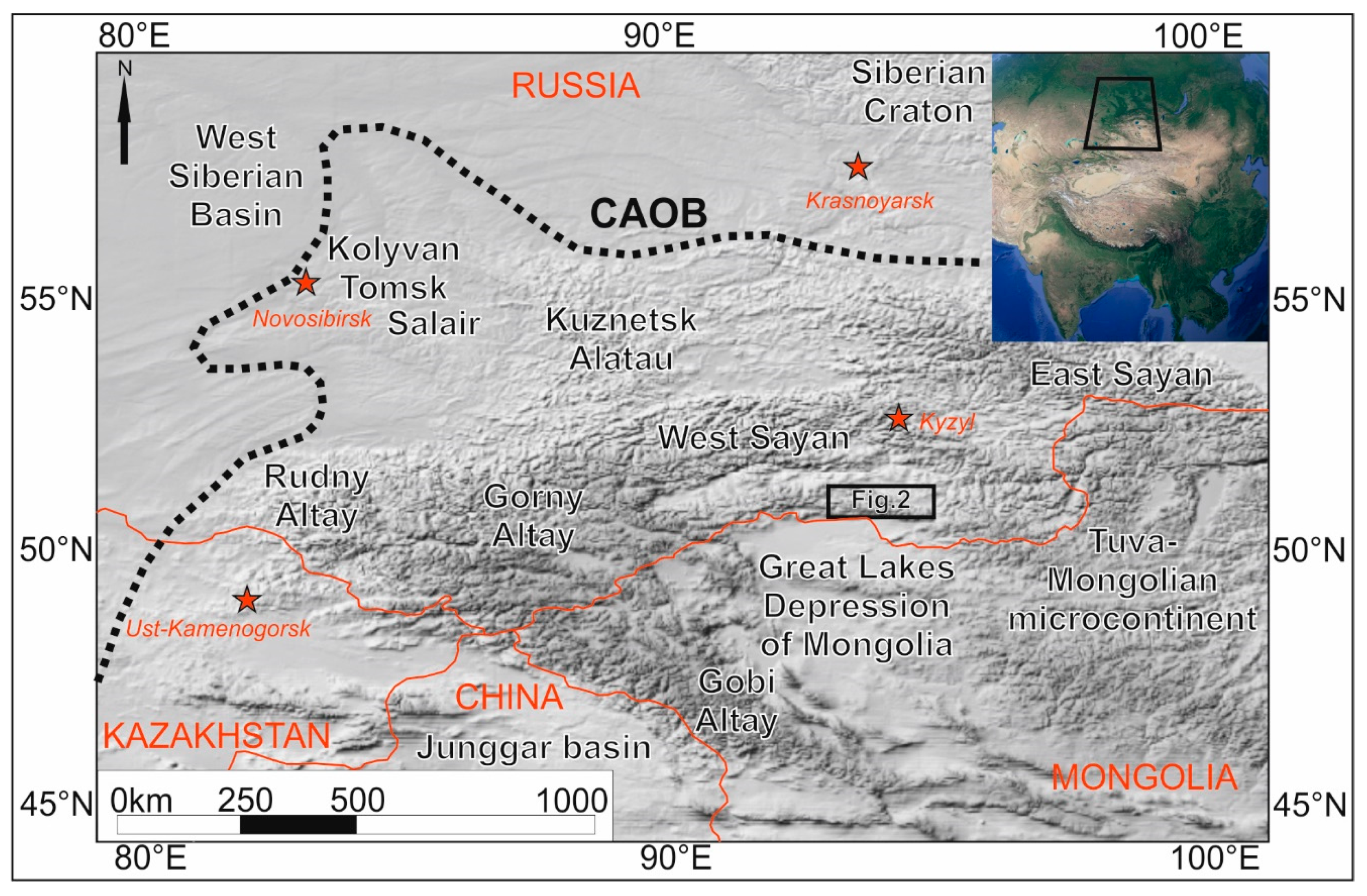
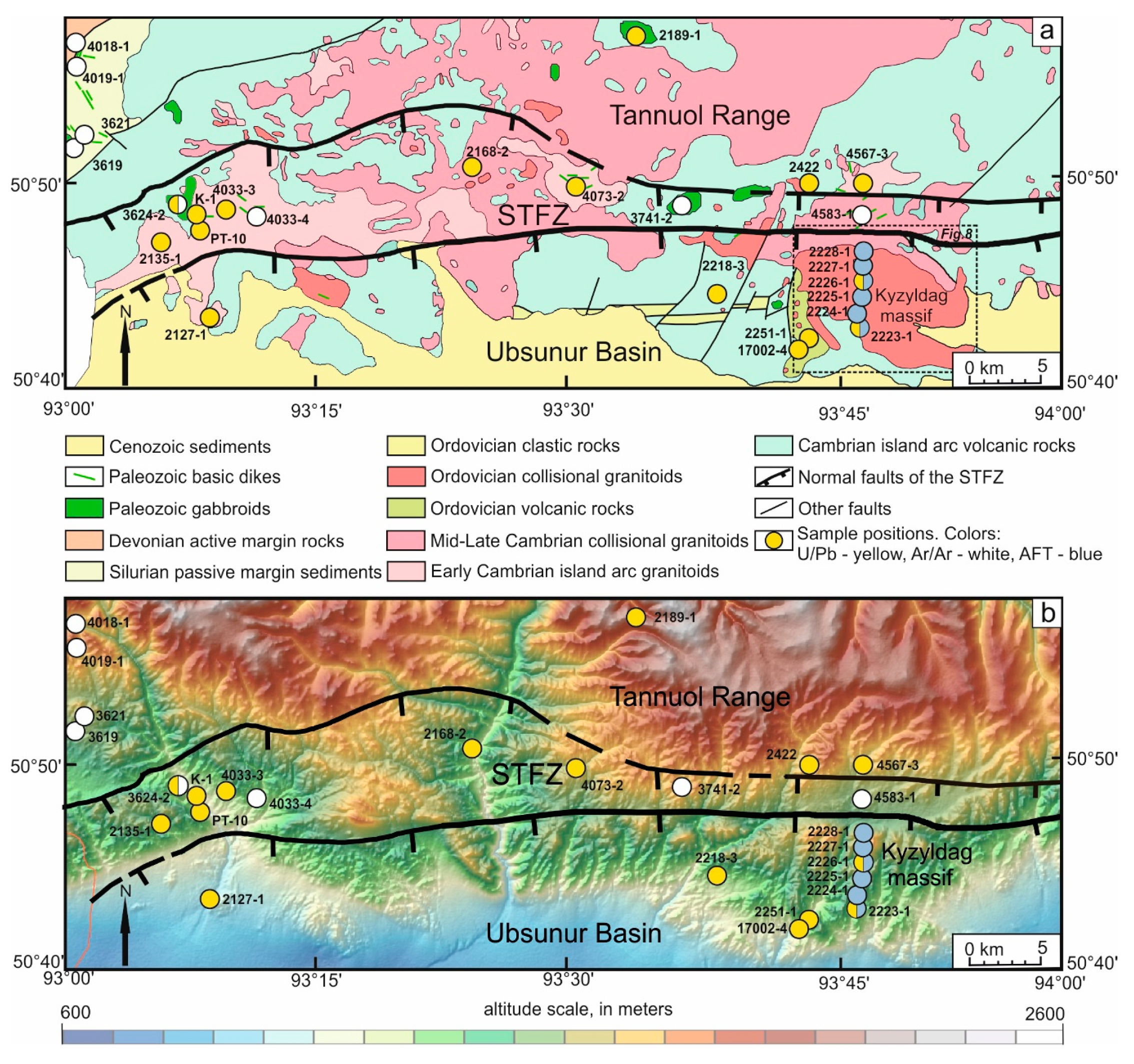
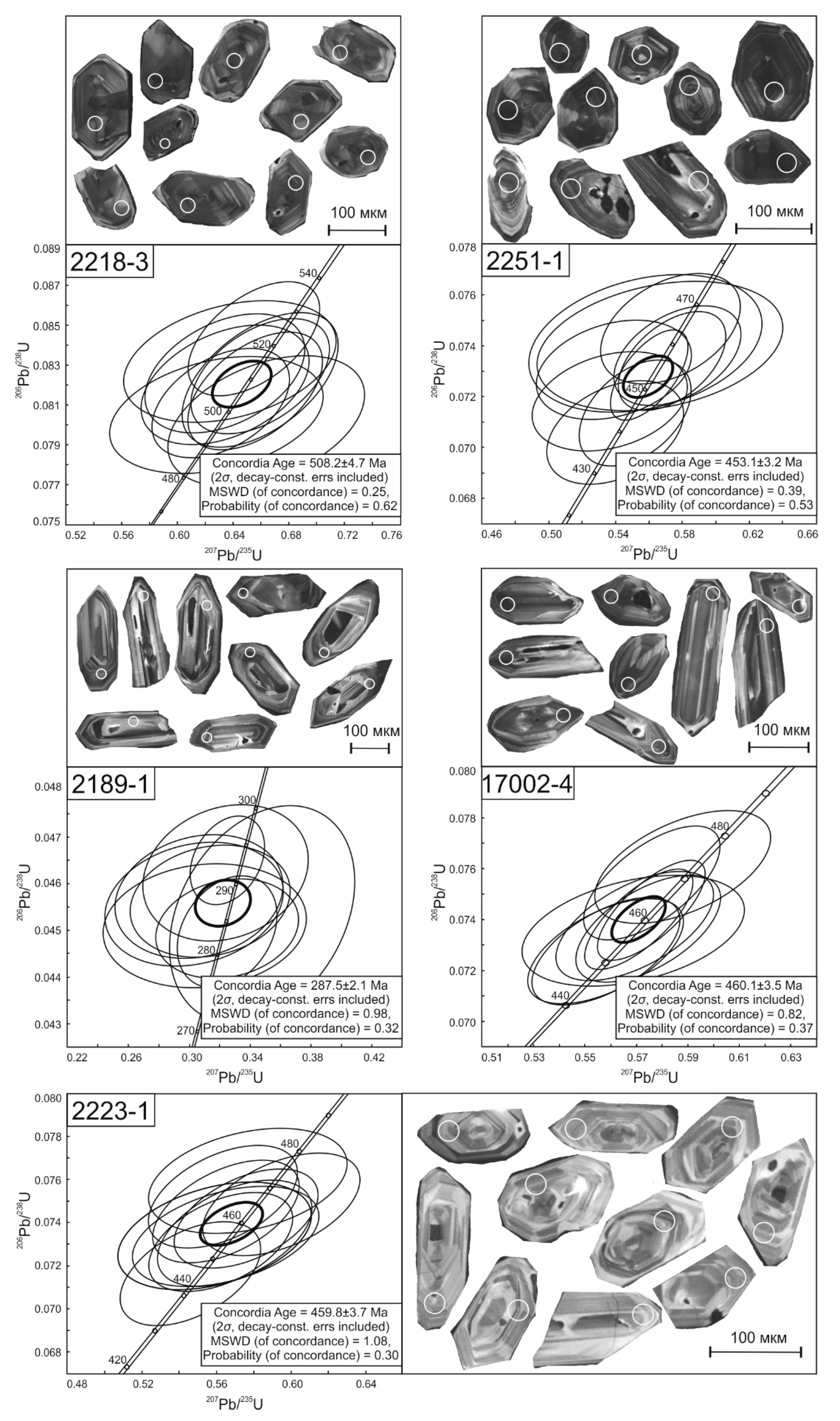
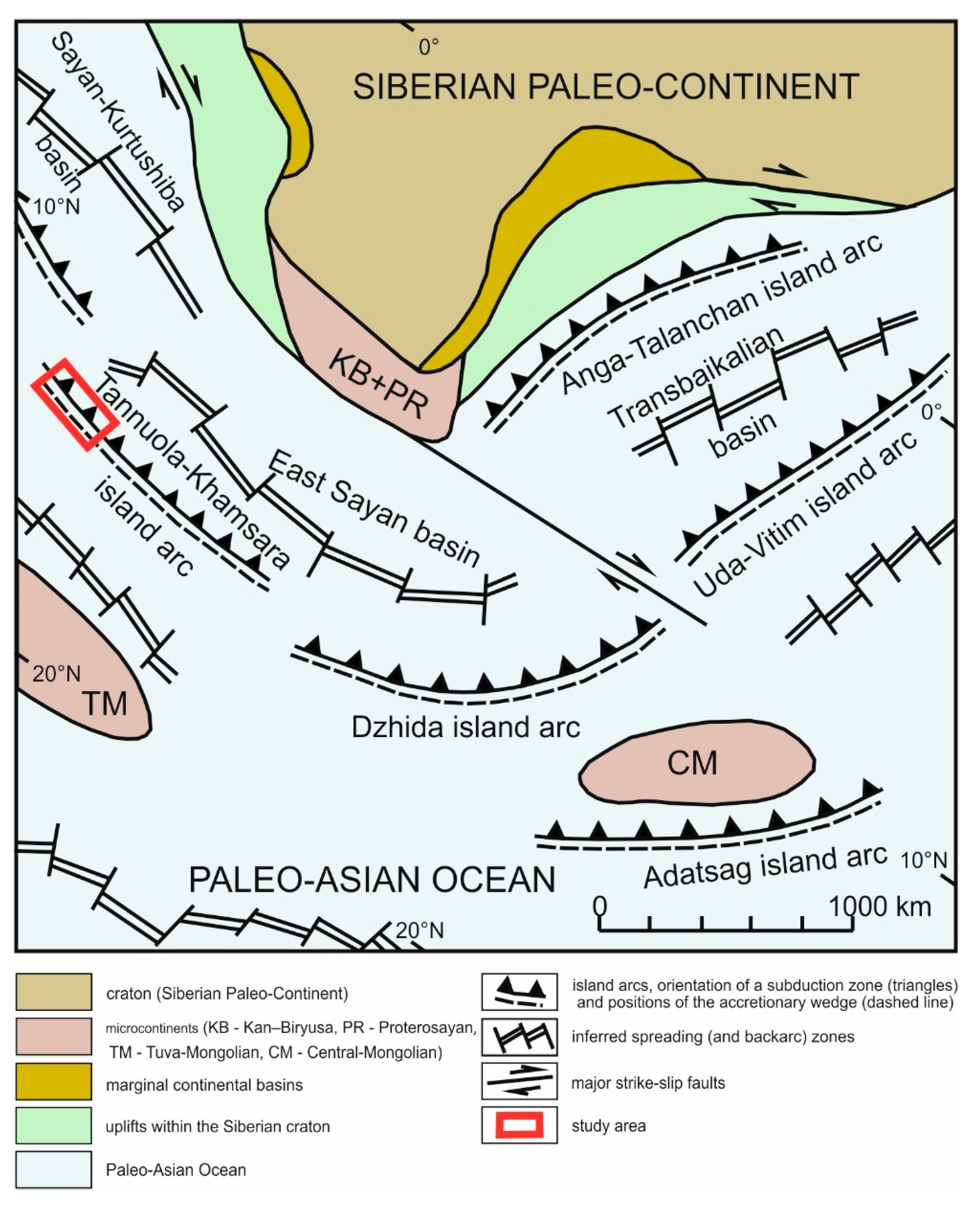
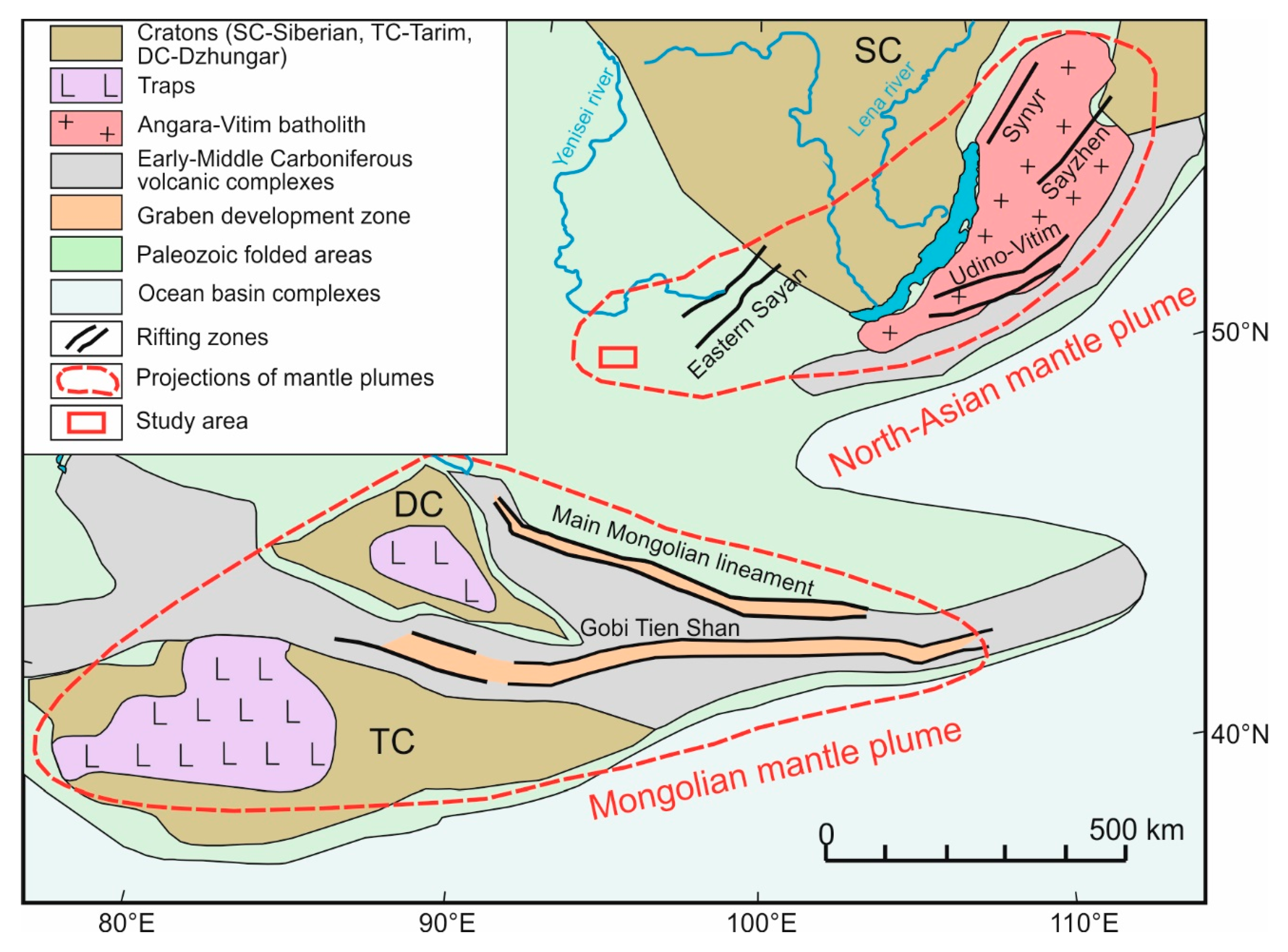
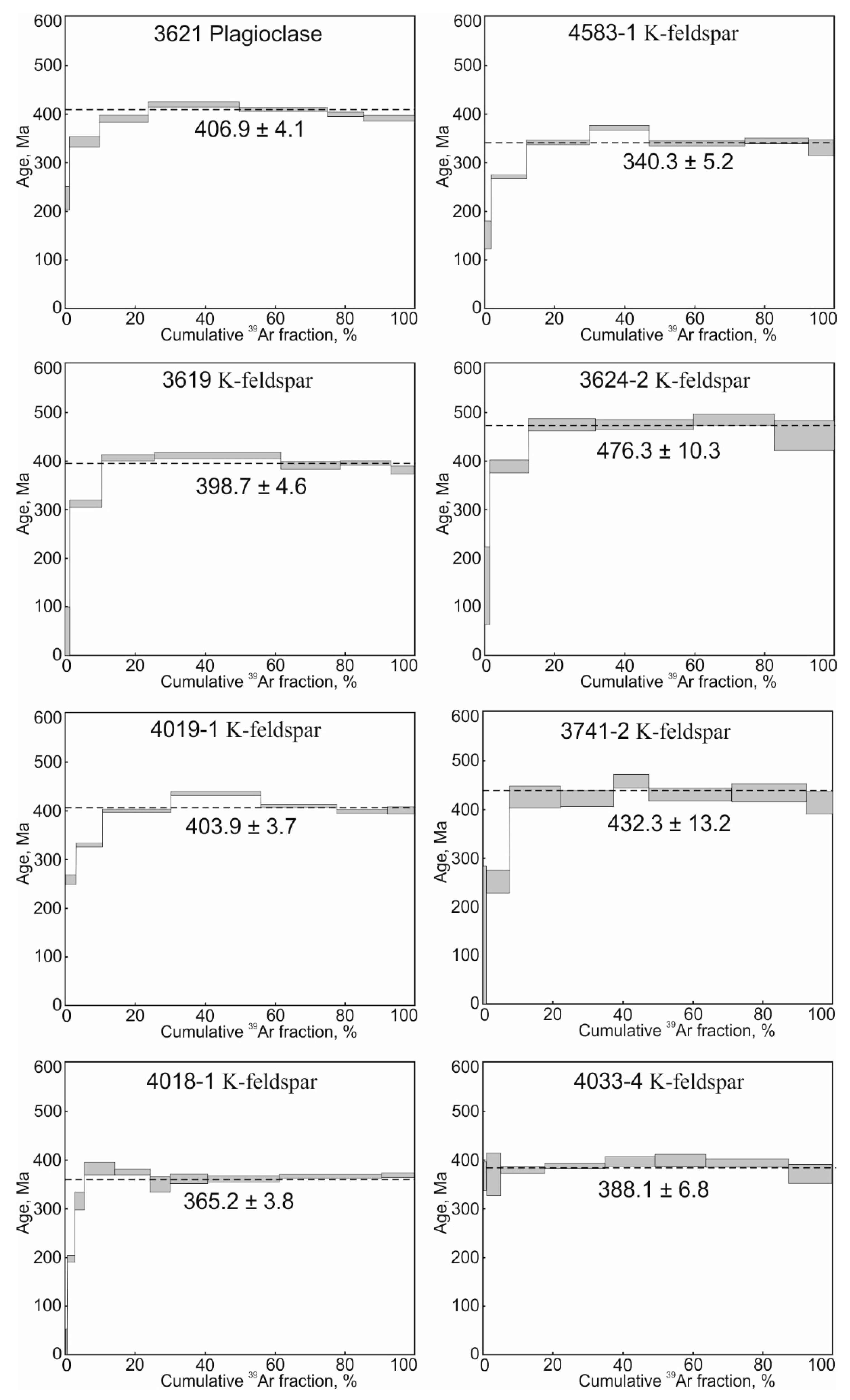
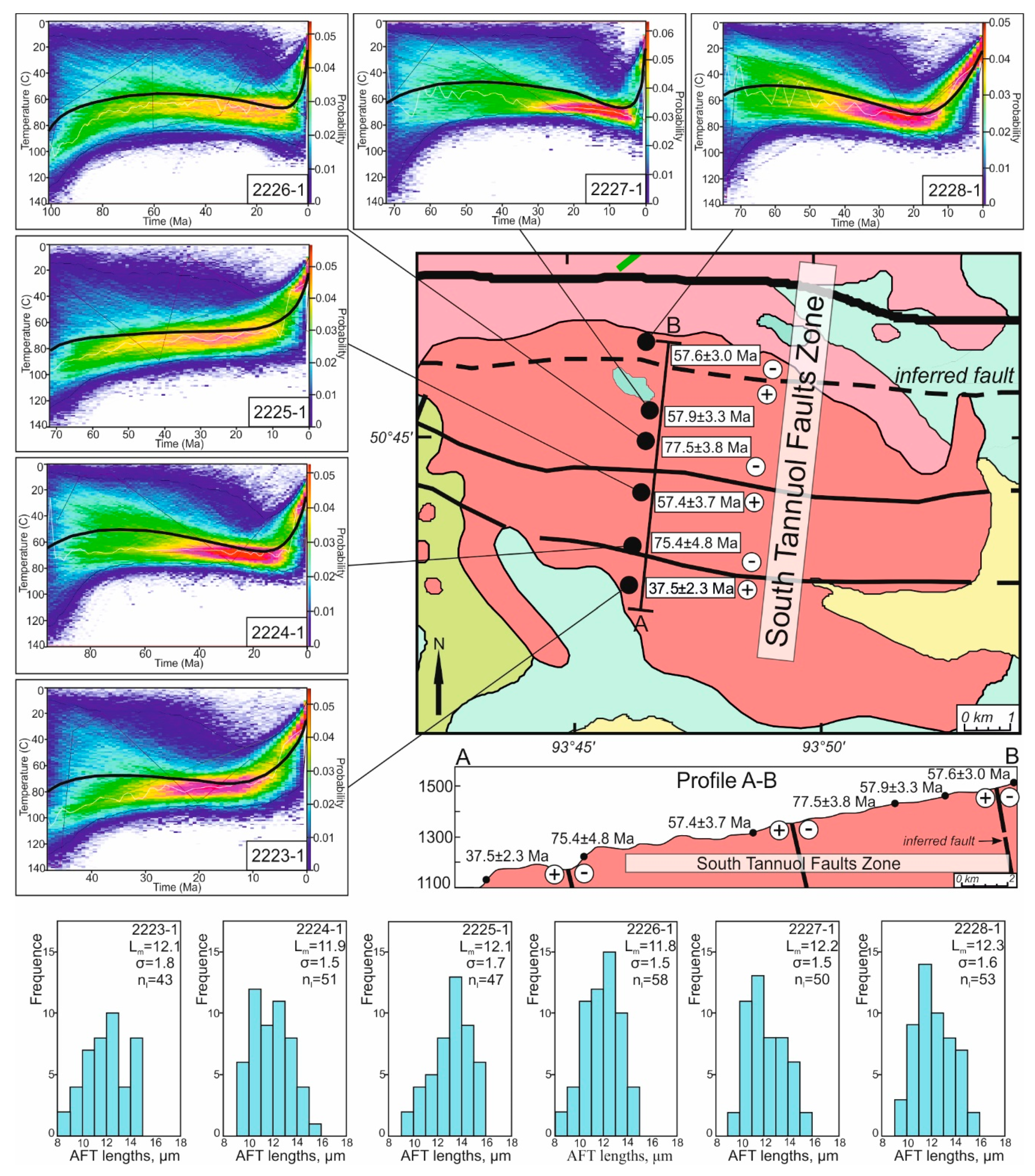
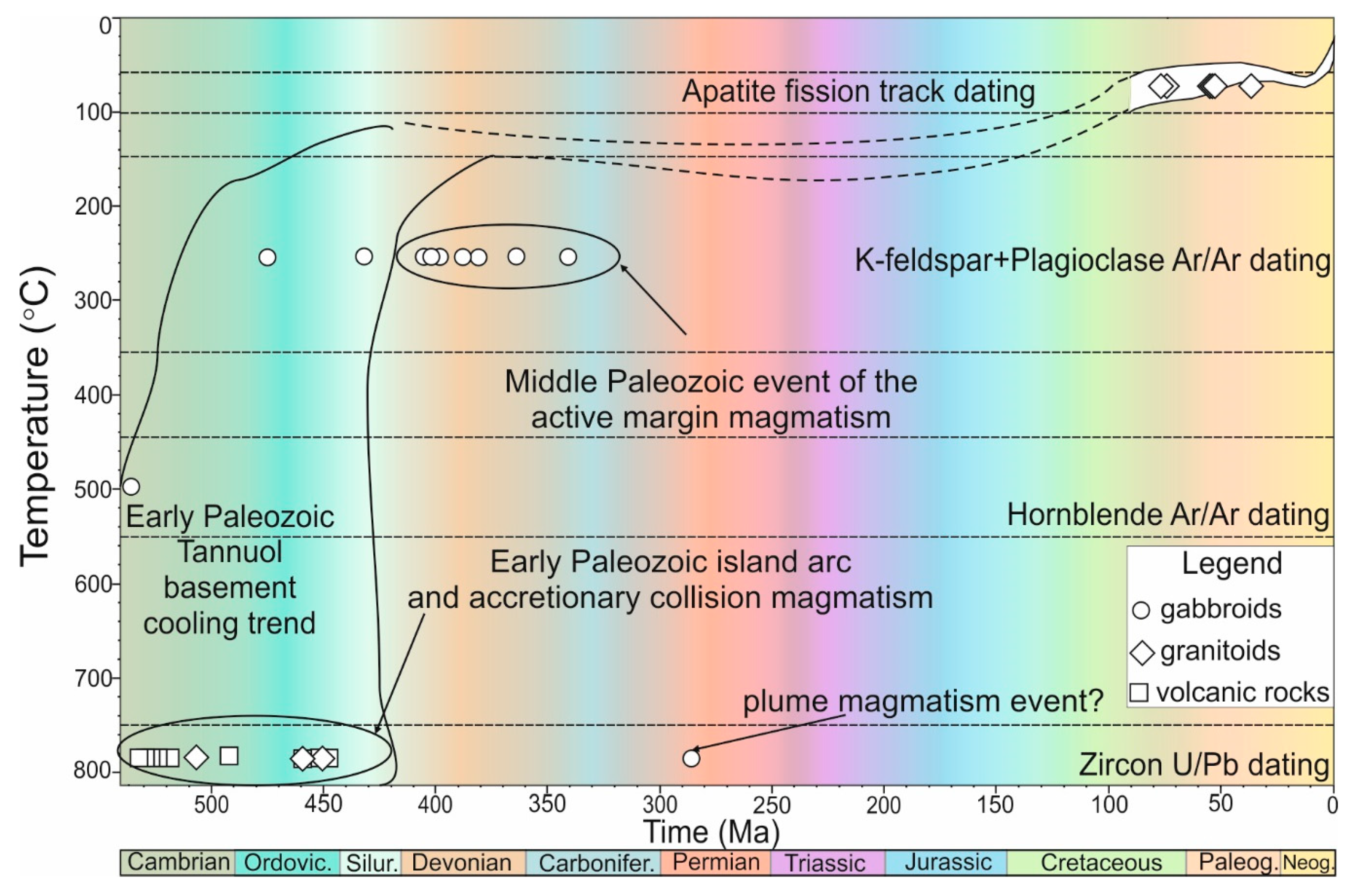
| № | Sample | Latitude | Longitude | Altitude | Lithology | Location | Method |
|---|---|---|---|---|---|---|---|
| 1 | 2218-3 | N50°46′04.42″ | E093°38′32.07″ | 1450 | rhyolite | East-Tannuol Range, Serligoruk river | ZUPb |
| 2 | 2251-1 | N50°44′08.64″ | E093°44′54.57″ | 1412 | rhyodacite | East-Tannuol Range, Despen river | ZUPb |
| 3 | 17002-4 | N50°43′45.26″ | E093°44′09.12″ | 1209 | rhyodacite | East-Tannuol Range, Despen river | ZUPb |
| 4 | 2189-1 | N50°55′53.44″ | E093°34′56.84″ | 2178 | gabbro | East-Tannuol Range, Doshtughem river | ZUPb |
| 5 | PT-10 | N50°47′44.9″ | E093°08′43.92″ | 1272 | quartz diorite | East-Tannuol Range, Irbitey river | ZUPb b |
| 6 | 2422 | N50°49′23.7″ | E093°44′48.69″ | 1805 | leucogranite | East-Tannuol Range, Bicheserlig river | ZUPb c |
| 7 | 2127-1 | N50°44′23.69″ | E093°09′40.55″ | 1008 | plagiogranite | East-Tannuol Range, Irbitey river | ZUPb c |
| 8 | 2168-2 | N50°49′40.01″ | E093°24′47.31″ | 1316 | diorite | East-Tannuol Range, Holu river | ZUPb c |
| 9 | 4073-2 | N50°49′45.89″ | E093°29′01.32″ | 1629 | plagiogranite | East-Tannuol Rang, Aptara river | ZUPb c |
| 10 | 4567-3 | N50°50′17.66″ | E093°46′13.91″ | 1875 | plagiogranite | East-Tannuol Range, Karasuk river | ZUPb c |
| 11 | 4033-3 | N50°48′40.07″ | E093°09′35.89″ | 1296 | plagiogranite | East-Tannuol Range, Tali river | ZUPb c |
| 12 | 2135-1 | N50°47′33.1″ | E093°06′33.13″ | 1392 | plagiogranite | East-Tannuol Range, Irbitey river | ZUPb c |
| 13 | K-1 | N50°49′38.8″ | E093°07′24.66″ | 1334 | gabbro | East-Tannuol Rang, Irbitey river | HblAr a |
| 14 | 3621 | N50°51′30.67″ | E093°01′44.49″ | 1577 | gabbro (dike) | East-Tannuol Range, Irbitey river | PlAr |
| 15 | 4583-1 | N50°49′28.62″ | E093°47′07.8″ | 1668 | gabbro (dike) | East-Tannuol Range, Karasuk river | FspAr |
| 16 | 3619 | N50°51′31.72″ | E093°01′00.2″ | 1580 | gabbro | East-Tannuol Range, Irbitey river | FspAr |
| 17 | 3624-2 | N50°49′01.93″ | E093°07′10.91″ | 1270 | gabbro | East-Tannuol Range, Irbitey river | ZUPb c, FspAr |
| 18 | 4019-1 | N50°53′33.89″ | E093°08′01.2″ | 1929 | gabbro (dike) | East-Tannuol Range, Irbitey river | FspAr |
| 19 | 3741-2 | N50°49′19.24″ | E093°36′02.8″ | 1770 | gabbro | East-Tannuol Range, Aptara river | FspAr |
| 20 | 4018-1 | N50°54′57.84″ | E093°00′51.22″ | 1857 | gabbro (dike) | East-Tannuol Range, Irbitey river | FspAr |
| 21 | 4033-4 | N50°48′42.01″ | E093°12′13.08″ | 1391 | gabbro (dike) | East-Tannuol Range, Tali river | FspAr |
| 22 | 2223-1 | N50°43′22.8″ | E093°48′25.20″ | 1145 | leucogranite | Kyzyldag massif | ZUPb, AFT |
| 23 | 2224-1 | N50°43′51.6″ | E093°48′25.20″ | 1226 | leucogranite | Kyzyldag massif | AFT |
| 24 | 2225-1 | N50°44′34.8″ | E093°48′43.20″ | 1313 | leucogranite | Kyzyldag massif | AFT |
| 25 | 2226-1 | N50°45′14.40″ | E093°48′50.4″ | 1439 | leucogranite | Kyzyldag massif | ZUPb c, AFT |
| 26 | 2227-1 | N50°45′50.4″ | E093°48′50.4″ | 1452 | leucogranite | Kyzyldag massif | AFT |
| 27 | 2228-1 | N50°46′22.8″ | E093°48′54″ | 1523 | leucogranite | Kyzyldag massif | AFT |
| Sample | 206Pbc, % | U, ppm | Th, ppm | 232Th/238U | 206Pb*, ppm | 207Pb*/206Pb* | ±, % | 207Pb*/235U | ±, % | 206Pb*/238U | ±, % | Age, Ma |
|---|---|---|---|---|---|---|---|---|---|---|---|---|
| 2218-3 | 0.111 | 132.6 | 74.9 | 0.576 | 9.353 | 0.05711 | 3.41 | 0.6459 | 3.75 | 0.08203 | 1.51 | 508.2 ± 4.7 |
| 2251-1 | 0.21 | 374.4 | 347 | 0.867 | 23.47 | 0.057128 | 2 | 0.55772 | 3.27 | 0.072945 | 1.19 | 453.1 ± 3.2 |
| 2189-1 | 0.399 | 174.9 | 162.1 | 0.891 | 7.134 | 0.05169 | 6.24 | 0.3542 | 6.37 | 0.04925 | 1.26 | 287.5 ± 2.1 |
| 17002-4 | 0.159 | 578.3 | 429.3 | 0.864 | 37.811 | 0.069068 | 1.72 | 0.70231 | 2.41 | 0.090191 | 1.44 | 460.1 ± 3.5 |
| PT-10 | 0.338 | 214.7 | 92.1 | 0.431 | 15.43 | 0.057744 | 3.31 | 0.66567 | 3.54 | 0.080568 | 1.23 | 521.9 ± 4.1 |
| 2422 | 0.279 | 299.6 | 186.3 | 0.646 | 18.54 | 0.056168 | 2.6 | 0.55547 | 2.69 | 0.07173 | 0.62 | 447 ± 2 |
| 2127-1 | 0.157 | 323.6 | 119.5 | 0.375 | 23.027 | 0.05791 | 2.87 | 0.6648 | 2.99 | 0.08328 | 0.9 | 518 ± 3 |
| 2168-2 | 0.143 | 174.3 | 77.8 | 0.45 | 11.891 | 0.05639 | 4.41 | 0.6178 | 4.77 | 0.0796 | 1.84 | 492.2 ± 5.5 |
| 4073-2 | 0.172 | 274.4 | 85.7 | 0.316 | 20.12 | 0.0574 | 2.82 | 0.6741 | 2.93 | 0.08518 | 0.83 | 526 ± 4 |
| 4567-3 | 0.24 | 430.5 | 272.5 | 0.613 | 31.36 | 0.058821 | 2.77 | 0.6886 | 2.92 | 0.08489 | 0.84 | 534 ± 3 |
| 4033-3 | 0.558 | 191.4 | 88.2 | 0.422 | 13.976 | 0.05992 | 6.14 | 0.6985 | 6.25 | 0.084567 | 1.05 | 524 ± 3 |
| 2135-1 | 0.378 | 220.3 | 125.4 | 0.543 | 16.157 | 11.7657 | 1.02 | 0.05604 | 4.87 | 0.6568 | 5.01 | 527 ± 3 |
| 3624-2 | 0.651 | 170.4 | 99.8 | 0.602 | 12.61 | 0.05604 | 5.7 | 0.6606 | 5.92 | 0.08552 | 1.05 | 529 ± 3 |
| 2223-1 | 0.133 | 145.2 | 103.1 | 0.728 | 9.25 | 0.05678 | 2.38 | 0.5679 | 3.11 | 0.73959 | 1.33 | 459.8 ± 3.7 |
| 2226-1 | 0.676 | 133.1 | 87.9 | 0.677 | 8.332 | 0.05435 | 7.21 | 0.542 | 7.35 | 0.07229 | 1.36 | 451 ± 4 |
| Sample | n | ρs (±1σ) | Nsc | ρi (±1σ) | Nic | ρd (±1σ) | Ndc | ρs/ρi | P(χ2) | t(ζ) | t(c) | lm (±1σ) | n1 | Dpar (±1σ) |
|---|---|---|---|---|---|---|---|---|---|---|---|---|---|---|
| 2223-1 | 26 | 2.289 (0.104) | 482 | 5.058 (0.155) | 1065 | 5.581 (0.124) | 2024 | 0.48 ± 0.03 | 0.94 | 37.5 ± 2.3 | 35.5 ± 2.2 | 12.1 ± 1.8 | 43 | 2.3 ± 0.4 |
| 2224-1 | 30 | 3.949 (0.161) | 603 | 4.209 (0.166) | 645 | 5.589 (0.124) | 2019 | 0.96 ± 0.05 | 0.96 | 75.4 ± 4.8 | 73.2 ± 4.6 | 11.9 ± 1.5 | 51 | 2.2 ± 0.3 |
| 2225-1 | 21 | 3.330 (0.149) | 509 | 4.885 (0,181) | 732 | 5.595 (0.125) | 2014 | 0.73 ± 0.04 | 0.80 | 57.4 ± 3.7 | 55.1 ± 4.8 | 12.1 ± 1.7 | 47 | 2.4 ± 0.5 |
| 2226-1 | 40 | 4.282 (0.126) | 1240 | 4.430 (0.124) | 1283 | 5.604 (0.125) | 2008 | 0.99 ± 0.04 | 0.42 | 77.5 ± 3.8 | 74.9 ± 3.8 | 11.8 ± 1.5 | 58 | 2.5 ± 0.5 |
| 2227-1 | 41 | 3.127 (0.115) | 741 | 4.263 (0.134) | 1010 | 5.611 (0.125) | 2003 | 0.74 ± 0.03 | 0.28 | 57.9 ± 3.3 | 56.8 ± 3.5 | 12.2 ± 1.5 | 50 | 2.2 ± 0.1 |
| 2228-1 | 36 | 4.722 (0.154) | 945 | 6.267 (0.177) | 1254 | 5.618 (0.126) | 1988 | 0.73 ± 0.03 | 0.83 | 57.6 ± 3.0 | 59.3 ± 3.1 | 12.3 ± 1.6 | 53 | 2.3 ± 0.4 |
© 2020 by the authors. Licensee MDPI, Basel, Switzerland. This article is an open access article distributed under the terms and conditions of the Creative Commons Attribution (CC BY) license (http://creativecommons.org/licenses/by/4.0/).
Share and Cite
Vetrov, E.; De Grave, J.; Vetrova, N.; Zhimulev, F.; Nachtergaele, S.; Van Ranst, G.; Mikhailova, P. Tectonic History of the South Tannuol Fault Zone (Tuva Region of the Northern Central Asian Orogenic Belt, Russia): Constraints from Multi-Method Geochronology. Minerals 2020, 10, 56. https://doi.org/10.3390/min10010056
Vetrov E, De Grave J, Vetrova N, Zhimulev F, Nachtergaele S, Van Ranst G, Mikhailova P. Tectonic History of the South Tannuol Fault Zone (Tuva Region of the Northern Central Asian Orogenic Belt, Russia): Constraints from Multi-Method Geochronology. Minerals. 2020; 10(1):56. https://doi.org/10.3390/min10010056
Chicago/Turabian StyleVetrov, Evgeny, Johan De Grave, Natalia Vetrova, Fedor Zhimulev, Simon Nachtergaele, Gerben Van Ranst, and Polina Mikhailova. 2020. "Tectonic History of the South Tannuol Fault Zone (Tuva Region of the Northern Central Asian Orogenic Belt, Russia): Constraints from Multi-Method Geochronology" Minerals 10, no. 1: 56. https://doi.org/10.3390/min10010056
APA StyleVetrov, E., De Grave, J., Vetrova, N., Zhimulev, F., Nachtergaele, S., Van Ranst, G., & Mikhailova, P. (2020). Tectonic History of the South Tannuol Fault Zone (Tuva Region of the Northern Central Asian Orogenic Belt, Russia): Constraints from Multi-Method Geochronology. Minerals, 10(1), 56. https://doi.org/10.3390/min10010056





